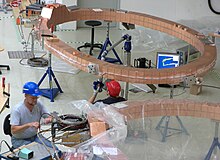
Back ستيلاراتور Arabic Стелларатор BA Стеларатор Bulgarian Stellarator Catalan Stelarátor Czech Stellarator German Stellarator Spanish Stellaraator ET Estelaratore EU استلراتور FA



A stellarator confines plasma using external magnets. Scientists aim to use stellarators to generate fusion power. It is one of many types of magnetic confinement fusion devices, most commonly tokamak. The name "stellarator" refers to stars because fusion mostly occurs in stars such as the Sun.[1] It is one of the earliest human-designed fusion power devices.
The stellarator was invented by American scientist Lyman Spitzer in 1951. Much of its early development was carried out by Spitzer's team at what became the Princeton Plasma Physics Laboratory (PPPL). Spitzer's Model A began operation in 1953 and demonstrated plasma confinement. Larger models followed, but demonstrated poor performance, losing plasma at rates far worse than theoretical predictions. By the early 1960s, hopes of producing a commercial machine faded, and attention turned to studying fundamental theory. By the mid-1960s, Spitzer was convinced that the stellarator was matching the Bohm diffusion rate, which suggested it would never be a practical fusion device.
The release of information on the USSR's tokamak design in 1968 indicated a leap in performance. After debate within the US industry, PPPL converted the Model C stellarator to the Symmetrical Tokamak (ST) as a way to confirm or deny these results. ST confirmed them, and large-scale work on the stellarator concept ended in the US replaced by tokamaks. Research continued in Germany and Japan, where several new designs were built.
The tokamak ultimately proved to have problems similar to the stellarators, but for different reasons. Since the 1990s, the stellarator design has seen renewed interest.[2] New methods of construction have increased the quality and power of the magnetic fields, improving performance.[3] A number of new devices have been built to test these concepts.
- ^ Clery, D. (2015). "The bizarre reactor that might save nuclear fusion". Science. doi:10.1126/science.aad4746.
- ^ Clery, D. (17 January 2013). "After ITER, Many Other Obstacles for Fusion Power". Science.
- ^ Gates, David A. Stellarator Research Opportunities: A Report of the National Stellarator Coordinating Committee. OCLC 1187827940.